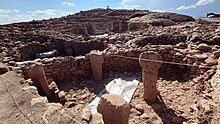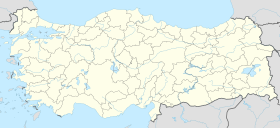Karahan Tepe
 Karahan Tepe | |
| Location | Karahan Tepe, Şanlıurfa Province, Turkey |
|---|---|
| Coordinates | 37°05′33″N 39°18′13″E / 37.09250°N 39.30361°E |
| History | |
| Periods | Pre-Pottery Neolithic A to B |
Karahan Tepe (Kurdish: Girê Keçel)[1][2] is an archaeological site in Şanlıurfa Province in Turkey. The site is close to Göbekli Tepe and archaeologists have also uncovered T-shaped stelae there and believe that the sites are related. According to Daily Sabah, "The excavations have uncovered 250 obelisks featuring animal figures" as of 2020[update]. Additionally, the site may be the earliest known human village, predating the construction of Göbekli Tepe, dating to between 9,000-11,000 BC.[3][4]
The site is located near Yağmurlu and roughly 46 kilometers east of Göbekli Tepe, which is often called its sister site.[4][5][6] It is part of the Göbekli tepe Culture and Karahan tepe Excavations project. The area is known as “Keçilitepe” by local people. It is part of a region of similar sites now being uncovered known as the Taş Tepeler.[4][7]
History
[edit]
The ancient structures at Karahan Tepe were discovered in 1997 by "researchers near the Kargalı neighborhood in the Tek Tek Mountains National Park."[8]
Necmi Karul, an archeologist at Istanbul University, told Anadolu Agency in 2019, “Last year, excavation work restarted in Karahan tepe [Kectepe] – around 60 km from where Göbekli tepe is located – and we encountered traces of special structures, obelisks, animal sculptures, and descriptions as well as similar symbolism”.[9] The site was filled with dirt and rubble at some point, preserving T-topped columns carved into bedrock.[10] These structures have been described as 'phallic totems'.[4]
Site
[edit]The Karahan tepe archaeological site covers almost 10 hectares, which increases by another five hectares if the quarries for the T-shaped columns are included.[11]
In September 2023, Turkish and German experts discovered further sculptures from the so-called Tepeler cultures: a statue of a vulture and a 2.3 m high anthropomorphic statue were found. The naked figure, which is probably depicted as sitting, holds his phallus with both hands. The fingers and ribs were marked with deep incised lines, and a kind of V-shaped collar around the neck. This same motif is also known from other finds, such as the so-called Urfa Man, an approximately 1.8 meter high sandstone statue that was discovered in 1993 during construction work near the city of Şanlıurfa.[12]
Images
[edit]References
[edit]- ^ "GIRÊ KEÇEL / QÛÇA KEÇEL KARAHAN TEPE - Europe's history is wrong it will be re-written - Heredotus should hear this !!". www.saradistribution.com. Retrieved 14 February 2024.
- ^ "Girê Miraza'nın kardeşi Girê Keçel ören yeri statüsüne alındı". www.rudaw.net. 26 September 2022. Retrieved 14 February 2024.
- ^ Agency, Demirören News (27 November 2020). "New Karahan tepe settlement may be older than Göbekli tepe". Daily Sabah. Retrieved 7 December 2020.
- ^ a b c d Thomas, Sean (8 May 2022). "Is an unknown, extraordinarily ancient civilisation buried under eastern Turkey?". Spectator Magazine. Retrieved 24 May 2022.
- ^ Spray, Aaron (31 October 2021). "Karahan Tepe is Called The 'Sister Site' Of Gobekli Tepe In Turkey (And Is Just As Old)". TheTravel. Retrieved 27 May 2022.
- ^ Collins, Andrew. "Karahan Tepe: Göbekli Tepe's Sister Site - Another Temple of the Stars?".
{{cite journal}}: Cite journal requires|journal=(help) - ^ "Karahantepe on way to be new face of Turkey". Hürriyet Daily News. 4 April 2020. Retrieved 7 December 2020.
- ^ "Karahantepe excavations start in Şanlıurfa". Hürriyet Daily News. 10 September 2019. Retrieved 7 December 2020.
- ^ . The site was preserved in part by being filled in with dirt and rubble at some point preserving columns and carvings such as a large human face.Kazanci, Handan (8 March 2020). "Turkey: Conservation, not excavation, focus in Gobeklitepe". Anadolu Agency.
- ^ "Arkeoloji Dergisi". Archived from the original on 31 August 2021. Retrieved 23 October 2021.
- ^ Karul, Necmi (2021). "Buried Buildings at Pre Pottery Neolithic Karahantepe / Karahantepe Çanak-Çömleksiz Neolitik Dönem Gömü Yapıları 2021". Türk Arkeoloji ve Etnografya Dergisi 86 (86): 22. ISSN 1302-9231.
- ^ Altuntaş, Leman (30 September 2023). "New discoveries in Göbeklitepe and Karahantepe: A Human statue with a realistic facial expression found in Karahantepe". arkeonews. Retrieved 1 October 2023.
Further reading
[edit]- Thomas, Sean (8 May 2022). "Is an unknown, extraordinarily ancient civilisation buried under eastern Turkey?". The Spectator.
- JUDITH SUDILOVSKY, 2022, "Oldest Neolithic settlements in Turkey redefine domestication, society" The Jerusalem Post, 27 May 2022: Oldest Neolithic settlements in Turkey redefine domestication, society
- TOLGA ILDUN, 2024, "Discovering a New Neolithic World""Discovering a New Neolithic World". Archaeology. Features: Archaeological Institute of America. 2024. Retrieved 2 May 2024.
- Tells (archaeology)
- 1997 archaeological discoveries
- Archaeological sites in Southeastern Anatolia
- Archaeological sites of prehistoric Anatolia
- Buildings and structures in Şanlıurfa Province
- History of Şanlıurfa Province
- Lost ancient cities and towns
- Megalithic monuments in the Middle East
- Neolithic sites of Asia
- Prehistoric art in Turkey
- Prehistoric Anatolia


















